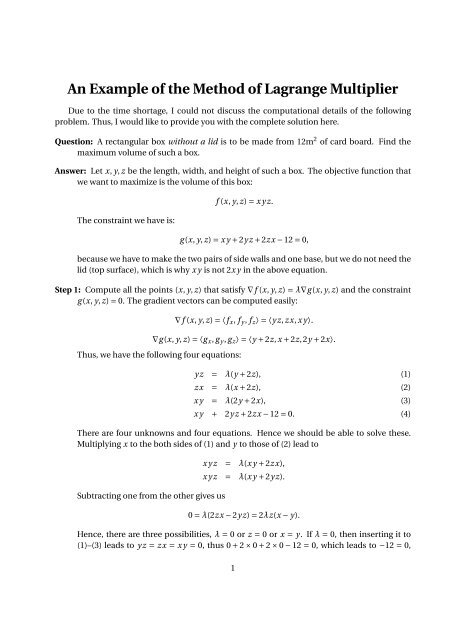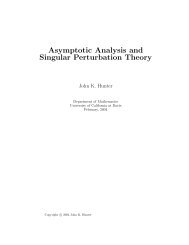An Example of the Method of Lagrange Multiplier
An Example of the Method of Lagrange Multiplier
An Example of the Method of Lagrange Multiplier
Create successful ePaper yourself
Turn your PDF publications into a flip-book with our unique Google optimized e-Paper software.
<strong>An</strong> <strong>Example</strong> <strong>of</strong> <strong>the</strong> <strong>Method</strong> <strong>of</strong> <strong>Lagrange</strong> <strong>Multiplier</strong><br />
Due to <strong>the</strong> time shortage, I could not discuss <strong>the</strong> computational details <strong>of</strong> <strong>the</strong> following<br />
problem. Thus, I would like to provide you with <strong>the</strong> complete solution here.<br />
Question: A rectangular box without a lid is to be made from 12m 2 <strong>of</strong> card board. Find <strong>the</strong><br />
maximum volume <strong>of</strong> such a box.<br />
<strong>An</strong>swer: Let x, y, z be <strong>the</strong> length, width, and height <strong>of</strong> such a box. The objective function that<br />
we want to maximize is <strong>the</strong> volume <strong>of</strong> this box:<br />
The constraint we have is:<br />
f (x, y, z) = x yz.<br />
g (x, y, z) = x y + 2yz + 2zx − 12 = 0,<br />
because we have to make <strong>the</strong> two pairs <strong>of</strong> side walls and one base, but we do not need <strong>the</strong><br />
lid (top surface), which is why x y is not 2x y in <strong>the</strong> above equation.<br />
Step 1: Compute all <strong>the</strong> points (x, y, z) that satisfy ∇f (x, y, z) = λ∇g (x, y, z) and <strong>the</strong> constraint<br />
g (x, y, z) = 0. The gradient vectors can be computed easily:<br />
∇f (x, y, z) = 〈fx, f y , fz〉 = 〈yz, zx, x y〉.<br />
∇g (x, y, z) = 〈gx, g y , gz〉 = 〈y + 2z, x + 2z,2y + 2x〉.<br />
Thus, we have <strong>the</strong> following four equations:<br />
yz = λ(y + 2z), (1)<br />
zx = λ(x + 2z), (2)<br />
x y = λ(2y + 2x), (3)<br />
x y + 2yz + 2zx − 12 = 0. (4)<br />
There are four unknowns and four equations. Hence we should be able to solve <strong>the</strong>se.<br />
Multiplying x to <strong>the</strong> both sides <strong>of</strong> (1) and y to those <strong>of</strong> (2) lead to<br />
Subtracting one from <strong>the</strong> o<strong>the</strong>r gives us<br />
x yz = λ(x y + 2zx),<br />
x yz = λ(x y + 2yz).<br />
0 = λ(2zx − 2yz) = 2λz(x − y).<br />
Hence, <strong>the</strong>re are three possibilities, λ = 0 or z = 0 or x = y. If λ = 0, <strong>the</strong>n inserting it to<br />
(1)–(3) leads to yz = zx = x y = 0, thus 0 + 2 × 0 + 2 × 0 − 12 = 0, which leads to −12 = 0,<br />
1
which is impossible. Thus, λ = 0. Also, z = 0 cannot happen since <strong>the</strong> height <strong>of</strong> <strong>the</strong> box<br />
must be positive. Therefore, we must have x = y. Inserting x = y to (3) leads to<br />
x 2 = 4λx,<br />
which leads to x = 4λ since x = 0. Plugging x = 4λ into (1) gives us<br />
4λz = λ(4λ + 2z) =⇒ z = 2λ.<br />
Therefore, we have x = y = 4λ and z = 2λ. Finally, inserting <strong>the</strong>se to <strong>the</strong> constraint equation<br />
(4) leads to<br />
16λ 2 + 4 · 2λ · 4λ − 12 = 0 =⇒ 4λ 2 − 1 = 0 =⇒ λ = ± 1<br />
2 .<br />
But we must have x > 0, y > 0, z > 0, to be a box. Thus, we must have λ = 1/2. This leads<br />
to x = y = 2, z = 1.<br />
Step 2: Since <strong>the</strong>re is only one such point, <strong>the</strong>re is no need to compare <strong>the</strong> function value at<br />
this point with that <strong>of</strong> <strong>the</strong> o<strong>the</strong>r point. Therefore <strong>the</strong> maximum volume <strong>of</strong> <strong>the</strong> box is<br />
f (2,2,1) = 2 · 2 · 1 = 4 m 3 .<br />
Note: If you want to make sure that this is <strong>the</strong> maximum volume, <strong>the</strong>n you can check<br />
<strong>the</strong> volume for some o<strong>the</strong>r values <strong>of</strong> (x, y, z) satisfying <strong>the</strong> constraint (4). For example,<br />
(x, y, z) = (1,1,11/4) is such a point. But it is clear that<br />
You must be satisfied by now!<br />
f (1,1,11/4) = 11/4 = 2.75 < 4 = f (2,2,1).<br />
2
















